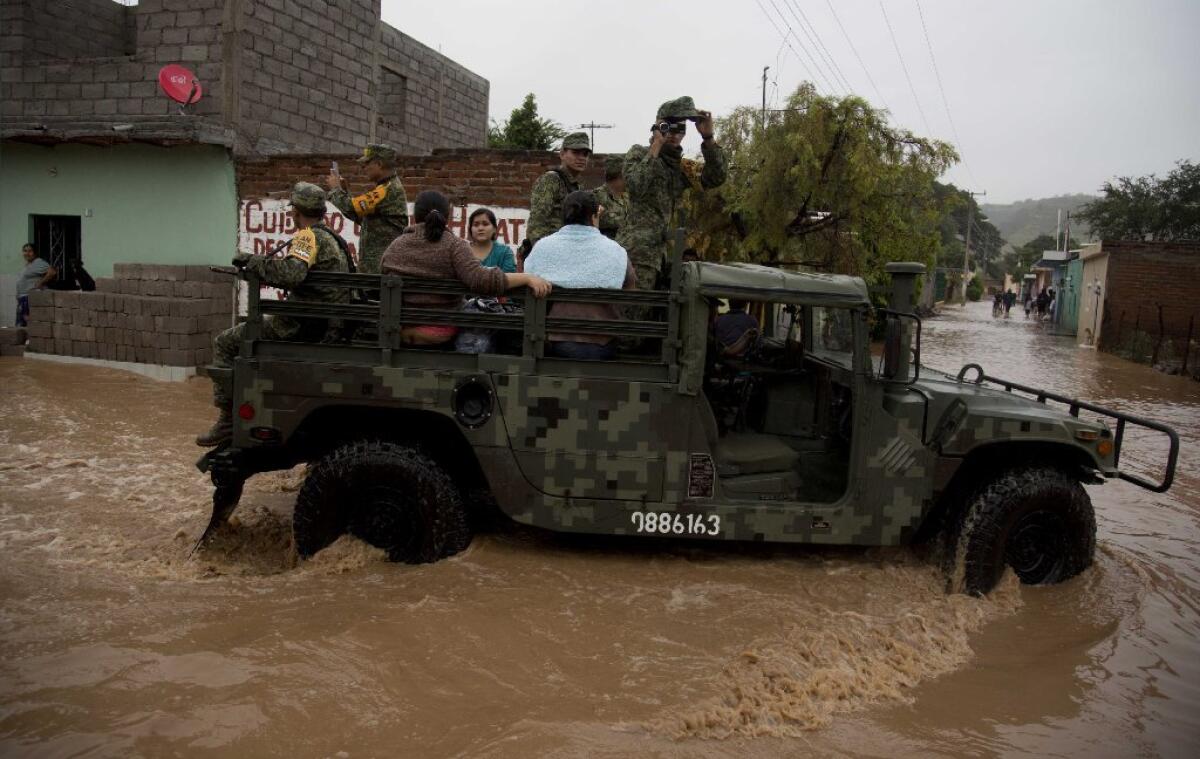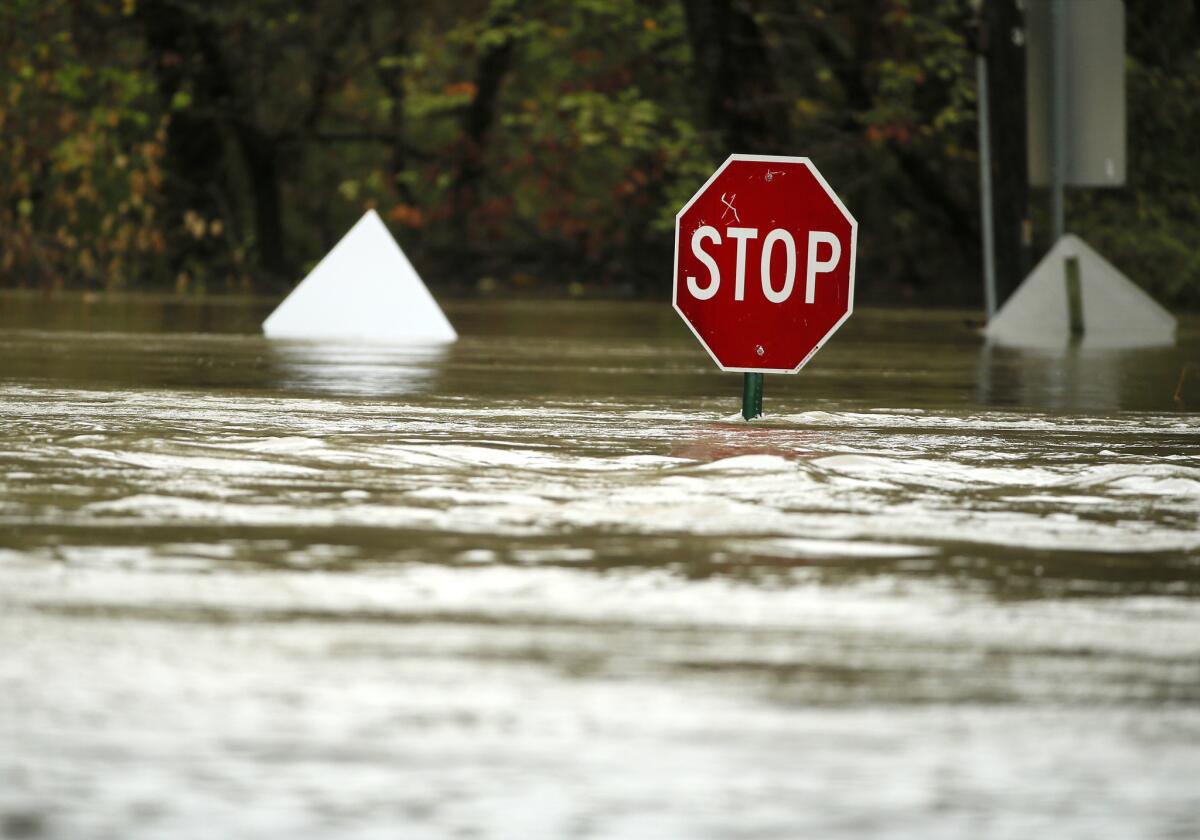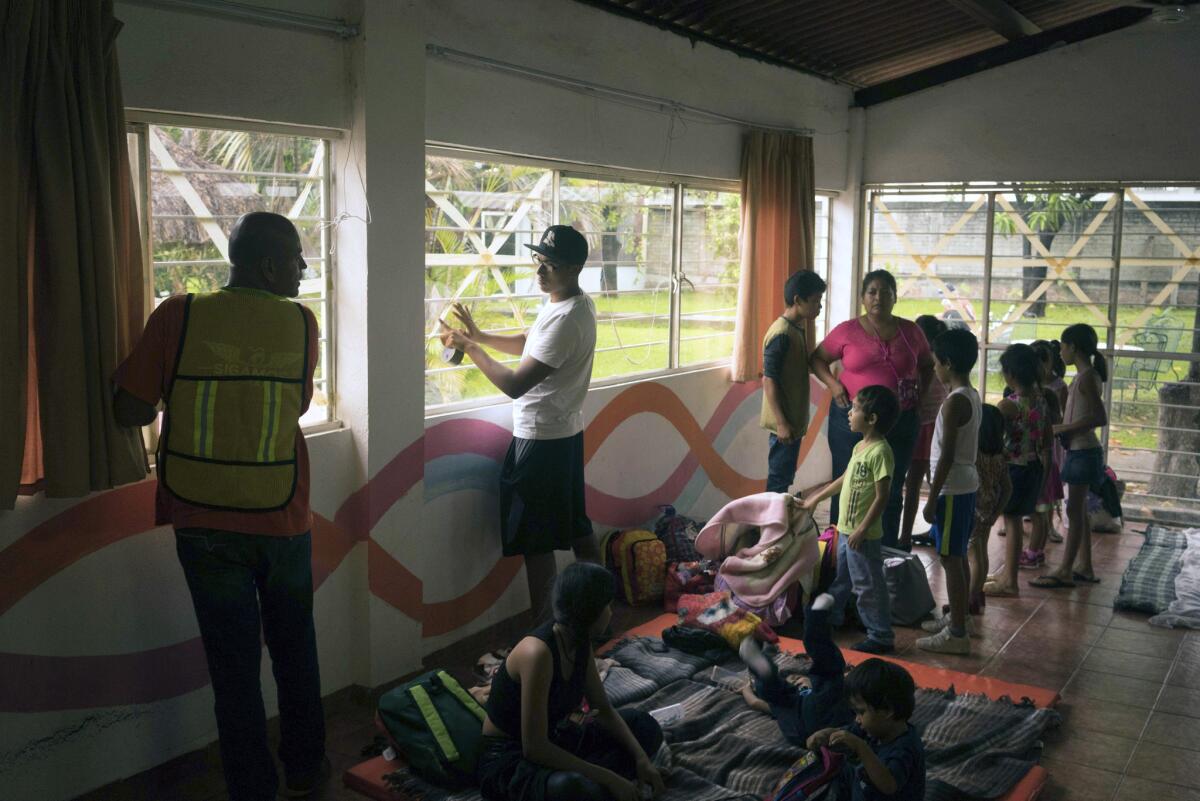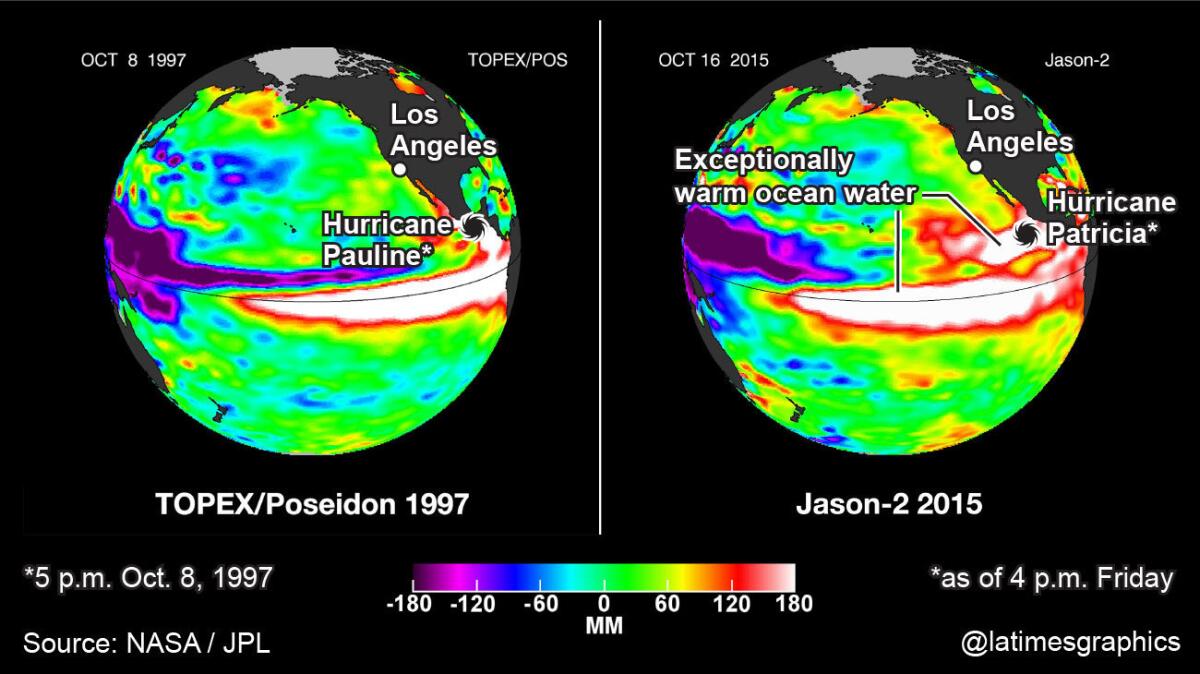Updates: Hurricane Patricia dissipates, but remnants could bring heavy rains to U.S. Gulf Coast
- Share via
Hurricane Patricia, the most powerful hurricane ever recorded in the Western Hemisphere, left several people injured and damaged buildings in rural areas of Mexico, but the storm's fury was largely neutralized as it traveled over coastal mountains early Saturday morning.
While the diminished storm caused several injuries and visible damage in the area of Jalisco, where it made landfall Friday night, Mexican officials had not reported any deaths as of 6 p.m. local time Saturday.
The remnants of Patricia are now expected to combine with a storm system forming near Texas. Meteorologists believe that storm will bring more than a foot of rain to coastal areas of Texas and Louisiana in the next several days.
While the storm did not bring the destruction many feared it would in Mexico, officials have warned that the massive rainfall brought by Patricia still could cause flooding and landslides.
- Track the hurricane.
- The storm has caused landslides and flooding, but no deaths or major damage have been reported.
- The governor of Jalisco said there were "significant injuries" in the area on Twitter, but he has not elaborated.
- The storm was downgraded to a post-Tropical cyclone around 4 p.m. local time, and was located in northeastern Mexico.
- Are you nearby or do you have family there? Tell us.
- Nueva informacion en español minuto por minuto.
Continued Patrica coverage from The Times
This live blog is now closing, but a team of Los Angeles Times correspondents and staff writers will provide continued coverage from Mexico and elsewhere.
For more news on the aftermath of Hurricane Patricia, follow:
Deborah Bonello, @mexicoreporter
Alan Zarembo, @Alan Zarembo
Molly Hennessy-Fiske, @mollyhf
Matt Pearce, @mattdpearce
Patricia's remnants will bring heavy rain to Gulf Coast

The remnants of Hurricane Patricia are likely to combine with another low pressure system and bring heavy rainfall to coastal areas of Texas and Louisiana, according to the National Hurricane Center.
Hurricane Patricia has been downgraded to a post-tropical cyclone, boasting winds of just 30 miles per hour as the storm travels across northeastern Mexico, according to the National Hurricane Center in Miami.
But as the storm fades, it will combine with another low-pressure system forming near Texas, resulting in heavy rain along the Gulf Coast this week, said Dennis Feltgen, spokesman for the center.
That marriage of weather systems could drop more than 13 inches of rain on waterlogged Texas and parts of coastal Louisiana, Feltgen said. Mississippi and Alabama could also see significant rainfall early next week, he said.
"We’ve got an area of low pressure, non-tropical, that’s forming along the Texas coast, and that’s going to pull in the remnant moisture from Patricia," Feltgen said.
“That’ll make a bad situation only worse,” he said, referring to heavy rain that has already pelted Texas this week.
The powerful winds whipped up by Patricia when it made landfall Friday night have all but disappeared, and the heavy rains that were swirling at the center of the storm had also severely weakened as of 4 p.m. local time, the hurricane center reported in an advisory.
Jalisco governor: No lives lost, but Patricia caused significant injuries
In a tweet, Aristóteles Sandoval, the governor of the state of Jalisco, warned that there were “significant injuries but fortunately no lost of life to mourn.” No other details were immediately available.
Residents in the area have reported damage to some structures and images of flooded plantations in the area have also surfaced on social media.
The storm was severely weakened overnight when it came inland and traveled over a mountainous region, but officials said Patricia's heavy rainfall still could lead to flooding and mudslides.
One family waited out Patricia inside a water park
Liliana Ramon Garcia, 34, and her five children sat out the storm from an unusual spot — the water slide park where they are the caretakers.
"It felt like the gazebo was going to come down," she said.
The family lives in a small apartment at the park, "Aquatic Jungle," and the storm threatened both their home and their livelihood.
But in the end, the damage was less severe: Umbrellas and plastic chairs were strewn about, a few signs were ripped down and dirty rainwater caused the pools to overflow.
"We'll be open again in a week," Ramon Garcia said.
Hurricane Patricia brings heavy flooding to Cihuatlan
Patricia damage report from Mexican coast: 'Nothing very serious'
Reports were circulating on social media Saturday of heavy damage in Cihuatlan, near the coast of Jalisco and Barra de Navidad beach where Hurricane Patricia made landfall Friday afternoon.
Photos on Twitter showed some flooding in the small town and people standing next to ruined street stalls.
But Omar Rojas from the local Civil Protection office said, aside from some uprooted trees and detached roofs, the damage in the area was minimal.
“There’s been no loss of life,” Rojas told the Los Angeles Times via telephone. “The river is high and there has been some flooding, but nothing very serious."
A look at Patricia's remnants from the International Space Station
Wrath of Patricia felt in rural towns
When Francisco Javier Rincon Manzo, 16, returned to his family's roadside fruit stand Saturday morning, he found that much of it had been blown away in the storm.
The apples, watermelons and bananas were all gone. He had spent the night hunkered down with family members in nearby Cihuatlan, just inland.
"We heard the winds screaming," he said. "Roofs were flying. Tree branches too."
The storm's fury lasted more than four hours, but his family's roof stayed on.
In Manzanillo, the storm is already a memory

In Manzanillo, a fisherman tries his luck in an inlet of the Pacific Ocean the morning after Hurricane Patricia passed through the city.
For many in Manzanillo, Patricia is already a thing of the past.
The sun was shining just past noon, and the port city's highways were basically clear of any debris.
And in an inlet of the Pacific, a fisherman was already trying to see if anything would bite.
Patricia may have wreaked havoc in smaller towns
While Puerto Vallarta, Manzanillo and other largely populated areas were mostly spared Patricia's wrath, the storm may have caused severe damage in smaller towns near the state of Jalisco, according to local media reports.
Patricia was still classified as a Category 5 hurricane when it made landfall near Jalisco on Friday, and officials remain concerned that the heavy rainfall brought by the storm will cause mudslides and flooding.
Univision's Enrique Acevedo was reporting that the storm made landfall in a rural area of Cuixmala and that damage likely would be more severe there.
As storm dissipates, flooding concerns remain

Soldiers evacuate residents to a shelter in Zoatlan, Nayarit state, some 150 km northwest of Guadalajara, Mexico.
With Patricia continuing to lose strength as it travels inland, officials in Mexico and the U.S. have shifted their focus to potential flooding and mudslides that could follow the storm's massive rainfall.
Rains could total eight to 12 inches and reach 20 inches in some isolated areas of Mexico. That volume of water could cause rivers to flood and undermine the soil, leading to possible mudslides.
“These rains are likely to produce life-threatening flash floods and mudslides,” the National Hurricane Center said. At risk were parts of the Mexican states of Nayarit, Jalisco, Colima, Michoacan and Guerrero through Saturday.
The storm is expected to travel to Texas and then across the western Gulf Coast through the weekend. Many parts of Texas, which were pounded by heavy rains earlier this week, were bracing for additional flooding Saturday.
Mountains severely weakened Patricia, experts say
Less than a day after Hurricane Patricia was described as the most powerful storm ever recorded in the Western hemisphere, most awoke to find minimal damage in the areas of Mexico where Patricia made landfall.
Why?
“Mountains. In a word, mountains,” is the reason the storm dissipated, said Dennis Feltgen, a spokesman for the National Hurricane Center in Miami. “These mountains disrupted the storm system, and they just tore it apart.
“It is also no longer over water, which is like fuel for hurricanes,” he said.
Patricia downgraded to tropical depression
The National Weather Service downgraded Patricia to a tropical depression at 10 a.m. local time.
Maximum sustained winds had decreased to just 35 miles per hour, the weather service said, as the storm traveled northeast toward central and northeastern Mexico.
The storm, which had been deemed the most powerful ever recorded in the Western Hemisphere, weakened substantially as it made landfall and caused far less damage than expected.
Patricia seems to have spared most states from serious damage
Less than 24 hours after Hurricane Patricia was dubbed the most powerful storm ever recorded in the Western Hemisphere, residents in the Mexican cities where the storm made landfall awoke to find minimal damage.
The tourist resorts of Manzanillo in Colima and Puerto Vallarta in Jalisco were reported to be calm and free from serious damage, in what Tourism Secretary Enrique de la Madrid described as a stroke of “extraordinary luck.”
Fallen lampposts, trees and billboards, accompanied by some flooding, appeared to be the extent of the damage in coastal communities. No deaths had been reported thus far from the 165-mph winds and torrential rains that battered the coast late Friday afternoon.
Officials preached caution, however, warning that it was still too early to know the full impact of the storm. Small villages in isolated mountainous regions that were exposed to the storm could have sustained serious damage, and landslides and flooding are still a possibility.
Storm leaves Mexican tourist towns soaked, but not seriously damaged
Roughly 24 hours after reports of Hurricane Patricia's power sent tourists and rescue officials scrambling across several Mexican states, most awoke Saturday morning to find the hurricane had caused far less damage than initially feared.
Images from Manzanillo and Puerto Vallarta, show people out and about on rain-slick streets, stepping around minimal debris to enjoy their Saturday morning.

Mexican soldiers remove sand from the street in Manzanillo, in the state of Colima, after Hurricane Patricia hit the shore of neighbouring Jalisco state. Patricia weakened to a tropical storm on Saturday, dumping heavy rain that triggered flooding and landslides, but so far causing less damage than feared.

A man walks his dogs along the seafront the morning after Hurricane Patricia passed further south, sparing Puerto Vallarta, Mexico. The storm made landfall Friday evening on Mexico’s Pacific coast as a Category 5 hurricane with maximum sustained winds of 165 mph (270 kph) but it is rapidly losing steam as it moves over a mountainous region inland from the shore.
Airports in Guadalajara and Puerto Vallarta resume operations
Airports in Guadalajara and Peurto Vallarta resumed operations early Saturday morning, according to Mexican federal police.
Flights into and out of several tourist areas in Hurricane Patricia's path had been canceled early Friday, as forecasts predicted a destructive and deadly storm.
Patricia was downgraded to a tropical storm early Saturday morning and could completely dissipate by Saturday night, the National Weather Service said.
Patricia weakens to a tropical storm
Patricia weakened to tropical storm force by dawn Saturday with maximum sustained winds of 50 mph and was expected to dissipate over Mexico's inland mountains. Its center was about 35 miles northeast of Zacatecas. It was moving north-northeast at 21 mph.
Patricia weakens to Category 1
Hurricane Patricia continues to weaken, dropping to a Category 1 storm as it crosses Mexico.
The storm's maximum sustained winds early Saturday had decreased to near 75 mph with rapid weakening expected to continue.
Patricia down to a Category 2 storm
As expected, the hurricane is weakening rapidly over Mexico's mountains. The hurricane's winds are down to 100 mph.
Storm's impact in isolated areas is unknown
Patricia's projected path is heading over a mountainous region dotted with hamlets that are at risk for dangerous mudslides and flash floods, and where communications can be sketchy. It wasn't clear when emergency crews would be able to fully assess the storm's impact in those areas, but authorities said air transport was being readied to perform search and rescue operations on Saturday morning.
A Friday night satellite view of the storm as it was moving toward the mountains:
As Patricia batters Mexico, Texas gets ready

A stop sign peeks above the water after heavy rains Dallas on Friday. Residents are bracing for more rain this weekend from storms fueled by massive Hurricane Patricia.
Parts of Texas were slammed by driving rainstorms Friday as emergency crews braced for the full impact of Hurricane Patricia, which could bring up to a foot of rain and trigger flash flooding across the state.
“We’re taking steps now for the worst-case scenario,” said Michael Walter, spokesman for the Houston Emergency Operations Center set to open Saturday afternoon to cope with the advancing storm.
Most of the state is now under a flood watch.
Puerto Vallarta tourists seem to be doing well, and getting married
Amid reports that Puerto Vallarta appeared to have been largely spared the worst, tourists holed up in evacuation centers there reported all is still fairly well in the midst of the storm.
David Wilkins, a 53-year-old sound and lighting production professional on vacation from Sunriver, Ore., was evacuated along with his wife from his hotel to a college in the hills of the city with hundreds of other evacuees.
“They fed us!” Wilkins said in an interview in a Facebook message. “Class rooms were clean.. desk style chairs around...there were about 25 to 30 [people] in each room. Water...blankets...ham sandwiches. ..we were well cared for by the support teams.”
Overall, Wilkins wrote, the mood was “calm,” with “lots of kids playing games with some of the staff...and grouchy old people.”
The center of the storm was recently reported to be about 75 miles southeast of the city:
Wilkins and his wife had been planning to leave at 4 p.m. Friday, but the airport shut down around midday, he said. They tried to make it onto the last flight out of the city but will try again Saturday.
Heidi Jones-DiSaia, 41, who is from Pittsburgh and is holed up in the ballroom of the Four Seasons Punta Mita, originally planned to leave Sunday but will have to see how the storm plays out.
Overall, she wrote, “I feel like we've been very lucky!!!”
Not every visitor was trying to skip town: Wilkins said there was a couple in his evacuation center who planned to get married at his hotel on Saturday.
“Patricia can’t stop love!” Wilkins wrote.
The current view from space
Patricia is now a Category 4 storm

The National Hurricane Center reports the hurricane, which was the most powerful ever recorded, has now been downgraded to a Category 4 storm.
It will continue weakening while it moves over Mexico, and is expected to become a tropical storm by tomorrow morning and a tropical depression by tomorrow afternoon.
The center is warning that the storm still remains extremely dangerous, and is expected to produce rainfall accumulations of 8 to 12 inches, and as much as 20 inches in isolated areas, in the states of Nayarit, Jalisco, Colima, Michoacan and Guerrero through Saturday. The rain is likely to cause flash floods and more mudslides.
"The good news is it's going to continue to weaken," said Dennis Feltgen, a spokesman for the hurricane center. "Once it moves inland it's cut off from the warm waters of the Pacific ocean, so it's going to lose its energy supply."
No reported deaths or major damage so far
The center of the storm made landfall in a relatively sparsely populated area about 55 miles northeast of the nearest major city, Manzanillo, and was expected to dissipate as it moved inland over a mountainous region with isolated hamlets.
There were reports of flooding and landslides as Hurricane Patricia swept into Jalisco state early in the evening, bringing lashing rain, crashing waves and winds as strong as a tornado.
The storm knocked down trees and light posts, but the state's governor said there had been no reported deaths or severe damage so far.
An earlier view of the lashing winds and rain in Manzanillo:
Guests at one Puerto Vallarta resort in good spirits
Bri Kromm, a registered nurse from Olympia, Wash., on vacation in Puerto Vallarta, had heard Thursday that a storm might be coming.
But on Friday morning, the staff at the Grand Mayan Nuevo Vallarta told guests that the situation had gotten much worse and that everyone would have to be evacuated.
As the storm hit Friday evening, Kromm was sheltering in the hotel’s parking garage with hundreds of other guests to safely wait out the wind and the rain. It wasn’t ideal, but the hotel made the best of the situation. Staff pulled all the pool chairs to the garage so that the guests would have somewhere to sit, and guests made themselves as comfortable as they could with chairs, blankets and pillows. Another person who said he was a guest at the hotel tweeted this photo of the setup:
The garage was hot, so staff brought in fans. There were outlets, so guests could take turns charging their devices and using wireless Internet to keep tabs on the storm and keep family and friends posted on the situation.
Kromm didn’t have phone service, so she conducted an interview with us over Facebook messages.
“We are incredibly lucky,” Kromm wrote. “We have nice bathrooms here and running water. … Everyone is in good spirits given the circumstances.”
Hotel staff told the guests the area had largely been spared and that Kromm and the other guests might be able to return to the main resort soon, but Kromm was still waiting on an announcement.
A street in Colima now
More on the evacuations
More than 1,200 shelters were set up in advance of the storm that were able to accommodate 240,000 people . While it remains unclear how many people went to the shelters, it's been estimated that tens of thousands of people up and down the coast were evacuated into shelters or out of the danger zone. Some left on government-provided flights and ground transportation, while others piled into cars and local buses.
About 3,000 soldiers and more than 800 federal police officers were dispatched to the area. A mobile hospital heading to Puerto Vallarta earlier today:
How many people are in the storm's path?

Residents and tourists take refuge in a small shelter as they await the arrival of Hurricane Patricia in Puerto Vallarta, Mexico.
It's not entirely clear. The storm was projected to hit Colima, Nayarit and Jalisco states. According to the 2010 census, there were more than 7.3 million inhabitants in Jalisco state alone, with more than 255,000 in the city of Puerto Vallarta. There were more than 650,000 people in Colima state, and more than 160,000 in Manzanillo, its largest city.
Tens of thousands of people have been evacuated from coastal areas, but there is no official word on how many might be now trying to ride out the storm on their own.

A cyclist rides along an empty street ahead of Hurricane Patricia, in Puerto Vallarta, Mexico.

As people begin to arrive, men try to secure the windows at a makeshift shelter from Hurricane Patricia, in the Pacific resort city Puerto Vallarta, Mexico.
Hurricane Patricia makes landfall with 165 mph winds
Hurricane Patricia hit land at 6:15 p.m. Central time, about 55 miles west-northwest of Manzanillo, according to the National Hurricane Center in Miami.
The storm carried maximum sustained winds of 165 mph when it made landfall, the hurricane center said.
The head of Mexico's water commission put landfall slightly earlier, at 5:40 p.m., and said the storm first hit a town in Jalisco called Emiliano Zapata.
Patricia making landfall
Early hurricane damage photos from Jalisco
Mexican federal police uploaded these photos from the beachfront village of Melaque in the state of Jalisco, close to where Hurricane Patricia was expected to make landfall.
El Niño: High-octane fuel for Hurricane Patricia

Hurricane Patricia, one of the most powerful hurricanes on record, formed in exceptionally warm waters in the eastern Pacific Ocean, with the hottest areas shown in white. The white areas show the highest sea levels, which are an indication of warmer-than-normal sea temperatures. Patricia formed during a strengthening El Nino, just like Hurricane Pauline did in October 1997.
Blame El Niño for pumping up one of the most ferocious hurricanes ever recorded.
Climatologists say that hurricanes feed off warm water, and the eastern Pacific is extraordinarily warm.
El Niño continues to power up in the Pacific. Hurricane Patricia is a another preview of the turbulent weather season ahead.
Patricia's winds are as fierce as a powerful tornado
Hurricane Patricia is packing sustained winds of about 200 mph, a Category 5 storm. To get a sense of Patricia’s power, consider the destructive winds of a tornado.
According to the Enhanced Fujita scale, the current standard for measuring tornadoes, winds less than 200 mph are considered an extreme danger, capable of leveling houses to rubble.
Patricia’s winds are technically as strong as an EF4 tornado.
Gusts of greater than 200 mph have also been measured in the hurricane, which would be the equivalent of the most powerful EF5 tornado.
That force is strong enough to wreck strong framed, well built houses, according to the National Weather Service. That would sweep away foundations, critically damage tall buildings or even collapse them.
Some cars, trucks and train cars can be picked up like toys and tossed up to a mile away.
Chivas vs. Atlas soccer match postponed
A soccer match scheduled for Saturday in Guadalajara has been postponed, one of the teams announced on Twitter.
The match between Guadalajara's Chivas club and Atlas has been rescheduled to Nov. 11.
Guadalajara is the capital of Jalisco state, one of several states threatened by the Category 5 storm.
High winds and surf in Manzanillo
Instagram user Hector R. Sanchez posted a series of videos of the approach of Hurricane Patricia from his perch along the coast in Manzanillo, Mexico.
One of them, posted early Friday afternoon, showed large waves churning just off the beach.
A couple of hours later, the waves appeared to have crashed over the beach wall and winds were whipping palm trees around.
On the Mexico coast, Manzanillo braces for Patricia's impact
Within the past hour, the wind has picked up in the coastal town of Manzanillo, and the rain has started slicing down at a 45-degree angle, said Lee Gonzales, an American missionary.
Gonzales and about 10 family members and friends have hunkered down on the second floor of his missionary nonprofit, Hope Fan, on the main road in Manzanillo.
Three hours ago, around 1 p.m. local time, residents had been scurrying through the streets to pick up food and water from suppliers who were quickly running out, said Gonzales, a Texas native, speaking by phone.
Now, with the rain slashing down and waves pounding the beaches, hardly anyone was outside except for the occasional passing police truck or Red Cross vehicle.
“Pretty much the streets are empty now,” Gonzales said.
Patricia hits Mexico almost 10 years to the day after Hurricane Wilma
On Oct. 21, 2005, Hurricane Wilma made landfall on the island of Cozumel, moving on to ravage the Yucatan peninsula for two days.
The storm lashed the Riviera Maya resorts, ripping roofs off buildings.
Hurricane Wilma was the previous record-holder for most intense hurricane in the Western Hemisphere, with a pressure of 882 millibars. Wilma also shattered records for the fastest-intensifying hurricane, dropping 88 mb in pressure in just 12 hours, almost double the rate of the previous record-holding storm, and had the smallest-ever recorded eye at 2 miles.
Tracking Hurricane Patricia
Hurricane Patricia grew over a 12-hour span and was upgraded to a Category 5 storm overnight. The hurricane has the strongest winds ever recorded in the Western Hemisphere. Keep track of its location with this interactive map.
'Tens of thousands' of Americans likely to be affected
State Department officials say they are "closely monitoring" the path of Hurricane Patricia, and estimated that tens of thousands of Americans may be living or traveling in the area and lkely to be affected.
"Obviously this is something we'll be watching closely in the hours and days to come, and offering whatever support we can," said State Department spokesman Mark Toner at a Friday briefing. He advised Americans in the affected areas to follow guidance from Mexican authorities.
President Obama tweeted Friday that USAID workers are on the ground.
Toner said he was not aware of any request for assistance from the Mexican government, but that U.S. officials are standing by and ready to help.
State Department issues travel alert
State Department officials have issued a travel alert for U.S. citizens in Mexico, advising them to take shelter as Hurricane Patricia approaches.
The Puerto Vallarta airport is closed, and the port has also been closed to all marine traffic. The Mexican government is setting up shelters in Jalisco state, officials said.
Travelers or their families can alert officials to U.S. citizens affected by the storm by calling +1-202-501-4444, or emailing PatriciaEmergencyUSC@state.gov.
Dramatic views: Patricia from the International Space Station
Outside the International Space Station, cameras captured dramatic views of Hurricane Patricia at 9:15 a.m. PDT on Oct. 23, as the mammoth weather system moved north at about 10 mph, heading for what the National Hurricane Center said could be a potentially catastrophic landfall along the southwest coast of Mexico.
Where is Patricia now?
Hurricane Patricia's center is located about 85 miles southwest of Manzanillo, Mexico, and about 155 miles south of Cabo Corrientes.
The storm is moving north at 12 mph and continues to have maximum sustained wind near 200 mph, with higher gusts.
The U.S. National Hurricane Center in Miami says Patricia is expected to remain an “extremely dangerous” Category 5 hurricane through landfall in the next several hours.
Afterward, Patricia is expected to rapidly weaken over the mountains of Mexico.
Thousands of soldiers dispatched to hurricane zone
About 3,000 soldiers and more than 800 federal police have been sent to the Mexican states of Colima, Nayarit and Jalisco to help prepare for Hurricane Patricia's landfall.
More than 10,000 tourists have been evacuated from Jalisco alone, officials said.
Most electricity in Nayarit has been cut as a precaution, according to Martin Tapia, head of civil protection in the state.
Tapia told a Mexican television station that people can expect to be without power for at least 24 hours.
What Hurricane Patricia looks like if you're an astronaut
Here's a shot from U.S. astronaut Scott Kelly from aboard the International Space Station.
Patricia grew to Category 5 hurricane with breakneck speed

(National Oceanic and Atmospheric Administration)
Hurricane Patricia’s peak winds exploded from 85 mph Thursday morning to more than 200 mph by early Friday, according to meteorologists. The storm grew at an “incredible rate” over a 12-hour span, the World Meteorological Organization said.
The last record-breaker, Hurricane Wilma in 2005, intensified from 150 mph to 184 mph in just under 5 1/2 hours.
Warm ocean water, calm winds in the atmosphere and a relatively compact storm structure helped spur the rapid intensification, experts said.
Facts to know about Hurricane Patricia
Patricia, a Category 5 hurricane, is the strongest storm ever in the Western Hemisphere, carrying winds of 200 mph.
Patricia could bring at least four hours of rain, totaling six to 12 inches. It is expected to hit Playa Perula, Mexico, near Manzanillo, on Friday night.
At midday Friday, a hurricane warning was in effect for the Pacific coast of Mexico, especially for the state of Jalisco, where heavy rains, flooding and winds are forecast. Guadalajara, in Jalisco, Mexico’s second-largest city, with a population of about 1.5 million.
A Category 5 hurricane hit Jalisco and Colima in western Mexico in 1959. It had winds of 160 mph and killed 1,800 people.
High winds could cause the sea to rise 39 feet, and the storm surge may bring flash floods and mudslides.
The storm's projected path:

The National Hurricane Center predicts Patricia’s path.
Flights in and out of Puerto Vallarta canceled
Flights between California and Puerto Vallarta, a major Mexican tourist destination, were canceled Friday as Hurricane Patricia approached.
A dozen flights between Puerto Vallarta and Los Angeles, San Francisco, Orange County and San Diego were canceled due to the historic storm, officials said.
A total of 31 flights connected to the resort city were canceled.
The National Oceanic and Atmospheric Administration recommended evacuatiion for anyone in low-lying coastal areas in the hurricane warning zone.
Local officials have said they expect the storm to make landfall around 4 p.m. PDT
How Hurricane Patricia morphed into a monster
Meteorologists are talking about Hurricane Patricia's stunning "rapid intensification." The rest of us can call it a hurricane explosion.
Sign up for Essential California
The most important California stories and recommendations in your inbox every morning.
You may occasionally receive promotional content from the Los Angeles Times.









